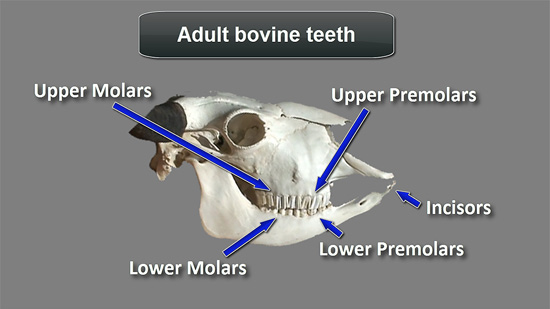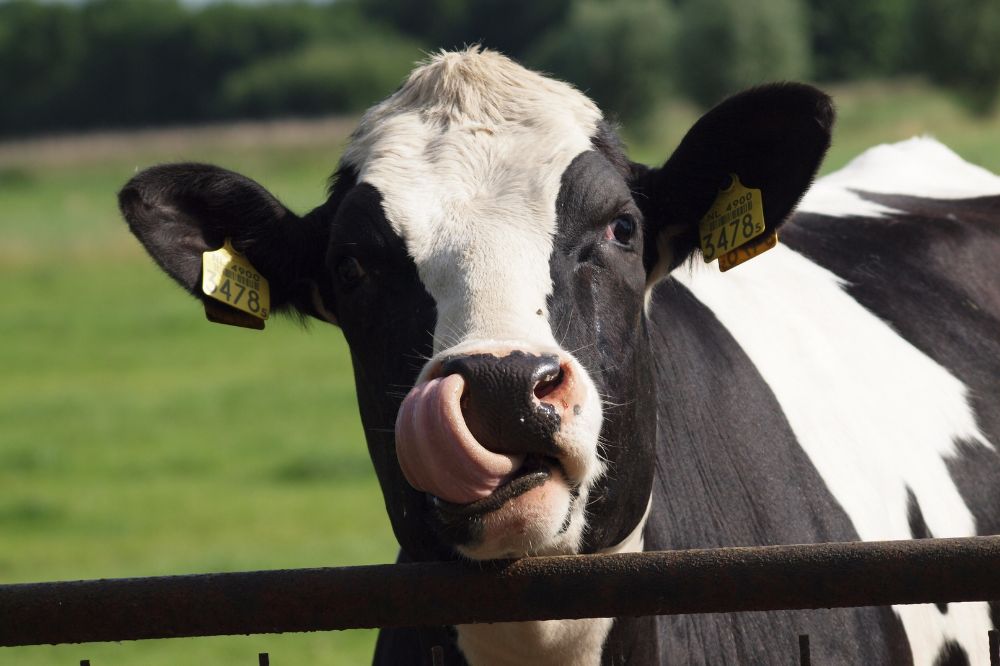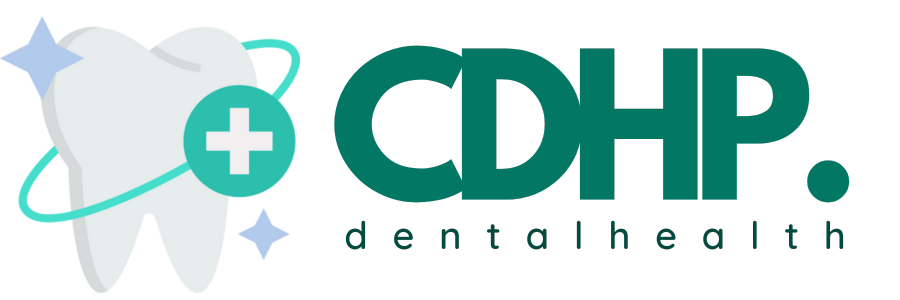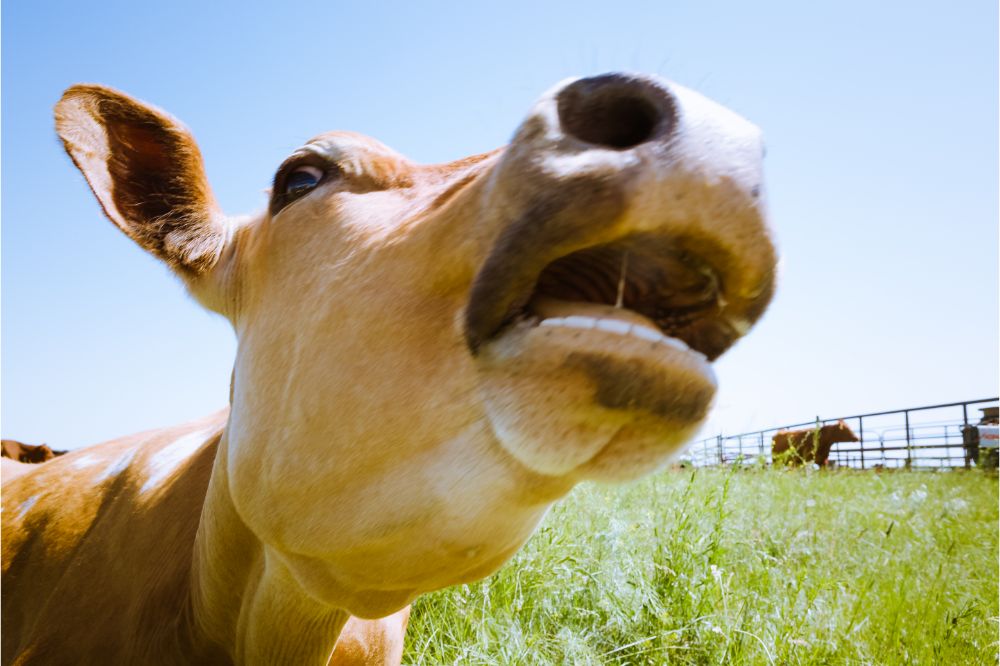Cows are among the most familiar and ubiquitous animals on the planet, and they are a common sight in fields in many parts of the world, wandering about grazing on grass and chewing the cud with bovine stoicism and indifference.
Table of Contents
However, if you’ve ever spent any time really looking at cows, you might have wondered a bit more about their teeth and digestive systems, so for anyone who’s curious, in this post, we look at the question, how many teeth do cows have?
How Many Teeth Do Cows Have? The short answer
Before we look at the question of how many teeth cows have in-depth, let’s start with a simple answer.
Cows are like humans in that they first grow baby teeth or milk teeth. When these are all grown, a young cow has 20 teeth in its mouth.
Later, these drop out, and the permanent teeth replace them. When the permanent teeth are all grown, an adult cow will have 32 teeth in its mouth.
So that’s it. A cow has 20 teeth when it’s a juvenile and 32 when it’s an adult.
However, there’s more to this topic than just that, so now let’s talk about cow teeth in more detail.
The different types of teeth and how they’re used
Cows have three types of teeth, incisors at the front of their mouths, premolars in the middle and molars at the back.
Together, the premolars and molars are known as “cheek teeth”, and there is a section between the incisors and the cheek teeth where no teeth are present.
Instead, they have a hard gumline which they use to chew and crush food before swallowing.
For more details on how cows eat, you can check out the FAQ section at the bottom.
Now let’s look at each of the three types of teeth in cows’ mouths in turn.

Image Credit: msstate
1. Incisors
What’s interesting about cows’ incisors is that, unlike us, they only have them on the bottom of the mouth and have none on the top.
A baby cow first grows eight incisors, and these then fall out and are replaced by eight new permanent incisors.
They are positioned at the front of the mouth just behind the lips, and on the upper jaw, instead of having incisors, a cow has a hard dental plate.
When a cow eats, it uses the incisors on the bottom and the dental plate on the top to grasp grass and other foods and rip them up. The incisors are not usually used to bite through food in the way that we bite through pieces of meat or an apple, for example.
Then, once a cow has food in its mouth, it gives it a preliminary “chew” with the gums to begin breaking it down and then swallows it – for the first time.
2. Premolars
A cow first grows a set of temporary premolars with three on either side of the mouth, both top and bottom, for a total of 12.
These then fall out and are replaced by permanent premolars later in the cow’s life. When the permanent premolars have all grown, there are also 12 of them in an adult cow’s mouth.
Along with the molars further back, the premolars are used for “chewing the cud” – again, for more details on this, you can check the FAQ section below.
3. Molars
When a cow is young, it doesn’t grow temporary molars – so when they erupt, they are the same molars the cow will have for the rest of its life.
An adult cow has three molars on each side, top and bottom, adding up to a total of 12. Along with the premolars, the molars are also used for chewing the cud.
When do cows grow their teeth?
When a baby cow is born, it usually has just two incisors – although sometimes it has none. However, by the time it is just one month old, the temporary incisors should all be present.
After this, the milk premolars will also erupt and then fall out, and the permanent cheek teeth will all grow. This will take place by about age three.
Finally, the milk incisors will also begin to fall out, and the cow will usually have a set of fully developed permanent teeth by about age five.
Don’t look a gift cow in the mouth

Have you ever heard the expression “don’t look a gift horse in the mouth”? This expression refers to a method for determining the age of horses by looking at the teeth.
You can tell how old a horse is by checking the eruption and wear of the teeth it has, and the expression is used to mean that if somebody gives you something for free, you should just receive the gift graciously rather than checking its quality.
Well, the same is true of cows – you can estimate the age of a cow by looking at which teeth it has and how worn they are. Since the milk teeth grow and fall out at about the same age for all cows, this can tell you how old the animal is.
Then, once all the milk teeth have fallen out, you can also estimate the cow’s age by examining the wear on its permanent teeth – although this method is less reliable since the amount of wear can also be affected by the cow’s diet and the coarseness of its food.
Here are the important dates in the development of a cow’s teeth:
- Birth – two or no incisors present
- One month – all incisors present
- 18-24 months – permanent central incisors appear, fully developed by 2 years
- 24-30 months – second permanent incisors appear, fully developed by 3 years
- 3 years – third permanent incisors appear, fully developed by 4 years
- 3 years – all permanent cheek teeth usually present
- 42-48 months – last permanent incisors appear, fully developed by 5 years
So if you don’t know the age of a cow, you can usually work it out using the development of its teeth.
After five years when all teeth are present, you can then also use the wear on the teeth to make a more approximate guess – but as we mentioned, this is less accurate than the appearance of milk and permanent teeth.
FAQs
Can cows bite?
Since cows don’t have upper incisors, you might be wondering if they can bite you.
Biting is not one of cows’ natural defense strategies – rather, they will kick to defend themselves, and they also have their horns.
However, a cow is physically capable of biting you, although it probably wouldn’t be too painful since your hand or whatever the cow got hold of would only be pinched between the incisors and the dental plate at the top of the mouth.
Indeed, the central incisors in a cow’s mouth are known as “pinchers”, although this is probably not the reason!
Do cows have four stomachs?
You may have heard that cows have four stomachs, but this is actually a myth. In reality, cows only have one stomach, but unlike ours, a cow’s stomach is divided into four parts, which is where the myth of having four stomachs comes from.
The four parts are known as the “rumen”, the “reticulum”, the “omasum” and the “abomasum”, and these four sections are what allow cows to digest food like grass and obtain the maximum amount of nutrients from it.
The last section, the abomasum, is equivalent to our stomach – but humans don’t have the other three parts.
How do cows eat and digest food?
Cows are ruminants, and as such, their teeth and digestive systems are perfectly adapted to making the most of low-nutrient food like grass by sending it down to their stomach and then regurgitating it to chew it again using their cheek teeth.
First, the food is swallowed with little or no chewing – although it may be crushed slightly by the hard gums between the incisors and the cheek teeth.
First, food is held in the rumen and is regurgitated mouthful by mouthful to be chewed at the back of the cow’s mouth by the molars and premolars. This is known as chewing the cud.
Once chewed up and broken down, the cud is then swallowed again and is further broken down in the rumen by microorganisms living there.
The generations of microorganisms in a cow’s stomach also provide the animal with a source of protein, which is not available from foods like grass.
The food then passes through the other three parts of the cow’s stomach, which each have further specific roles to play, and waste is then ejected out of the other end.
How do you know which teeth are milk teeth and which are permanent?
If you spend much time with cows, you’ll quickly learn to identify milk teeth and permanent teeth on sight.
Milk teeth are smaller and whiter while permanent ones are bigger and more colored.
Perfectly adapted teeth and digestive systems for their lifestyle
As we’ve seen, young cows have 20 teeth while adult cows have 32 – and what’s more, their teeth and digestive systems are perfectly adapted to the food they eat and the way they live.
It’s also possible to tell the age of a cow – or at least make a close guess – by looking at how many milk teeth or permanent teeth it has, which makes knowing something about cows’ teeth practical knowledge rather than just something that’s simply quite interesting.

